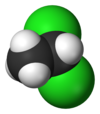1,1-Dichloroethane
|
|
|||
| Names | |||
|---|---|---|---|
|
IUPAC name
1,1-Dichloroethane
|
|||
| Other names
ethylidene dichloride
ethylidene chloride CFC-150a 1,1-DCA Asymmetrical dichloroethane 1,1-Ethylidene dichloride geminal dichloroethane |
|||
| Identifiers | |||
|
3D model (Jmol)
|
|||
| ChemSpider | |||
| ECHA InfoCard | 100.000.785 | ||
| KEGG | |||
|
PubChem CID
|
|||
|
|||
|
|||
| Properties | |||
| C2H4Cl2 | |||
| Molar mass | 98.96 g/mol | ||
| Appearance | colorless, oily liquid | ||
| Odor | chloroform-like | ||
| Density | 1.2 g/cm3 | ||
| Melting point | −97 °C (−143 °F; 176 K) | ||
| Boiling point | 57.2 °C (135.0 °F; 330.3 K) | ||
| 0.6% | |||
| Vapor pressure | 182 mmHg (20°C) | ||
| -57.4·10−6 cm3/mol | |||
| Hazards | |||
| Flash point | −17 °C; 2 °F; 256 K | ||
| Explosive limits | 5.4%-11.4% | ||
| US health exposure limits (NIOSH): | |||
|
PEL (Permissible)
|
TWA 100 ppm (400 mg/m3) | ||
|
REL (Recommended)
|
TWA 100 ppm (400 mg/m3) | ||
|
IDLH (Immediate danger)
|
3000 ppm | ||
| Related compounds | |||
|
Related compounds
|
1,2-Dichloroethane (ethylene dichloride); *1,1-Dichloroethene | ||
|
Except where otherwise noted, data are given for materials in their standard state (at 25 °C [77 °F], 100 kPa).
|
|||
|
|
|||
| Infobox references | |||
1,1-Dichloroethane is a chlorinated hydrocarbon. It is a colorless oily liquid with a chloroform-like odor. It is not easily soluble in water, but miscible with most organic solvents.
Large volumes of 1,1-dichloroethane are manufactured, with annual production exceeding 1 million pounds in the United States. It is mainly used as a feedstock in chemical synthesis, chiefly of 1,1,1-trichloroethane. It is also used as a solvent for plastics, oils and fats, as a degreaser, as a fumigant in insecticide sprays, in halon fire extinguishers, and in cementing of rubber. It is used in manufacturing of high-vacuum resistant rubber and for extraction of temperature-sensitive substances. Thermal cracking at 400–500 °C and 10 MPa yields vinyl chloride. In the past, 1,1-dichloroethane was used as a surgical inhalational anesthetic.
In the atmosphere, 1,1-dichloroethane decomposes with half-life of 62 days, chiefly by reaction of photolytically produced hydroxyl radicals.
...
Wikipedia


